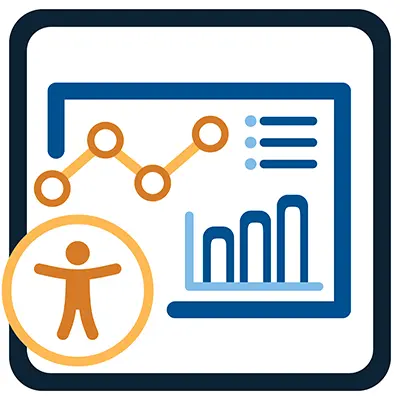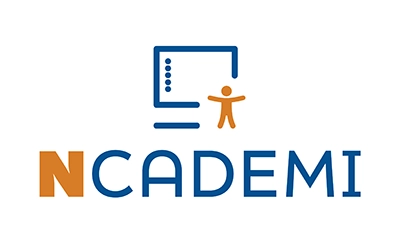
Statement
State and local educational agencies (SEA and LEAs) continuously measure progress toward a sustainable coordinated system for the provision and use of accessible digital educational materials.
Intent
Ongoing assessment is necessary to ensure the agency’s actions are effectively contributing to improvements in the accessibility of digital educational materials. Feedback is gathered from multiple sources—products, students, families, and educators—with strong protections for privacy. These data are used to inform decisions about procurement, training, instructional practice, and student support.
Critical Components
To effectively address Quality Indicator DM6, the following components should be present:
DM6.1 Inventory of EdTech Accessibility
An ongoing inventory of accessibility information available for all edtech applications, products, and curriculum provided by the agency, and use of this record to prioritize the replacement of inaccessible products over time.
DM6.1 Self-Assessment Scoring Matrix
| Not Started | Emerging | Operationalizing | Scaling & Sustainability |
|---|---|---|---|
| The need for an inventory of accessibility information for the edtech applications and products provided by the agency has not yet been considered. | The SEA and LEAs (“the agency”) are identifying all edtech products currently in use and developing a framework for tracking their accessibility status. Designated staff are exploring what accessibility data to include (e.g., ACRs, user testing results, vendor commitments, student-reported barriers) and how to maintain the inventory. Internal conversations are underway about how these data will inform decisions. | The agency has an inventory that includes accessibility documentation of agency-approved edtech products, as well as notes on any known accessibility barriers. Data are being collected from vendor reports, staff experiences, and user feedback. The agency uses this inventory to inform training, guidance for educators and decisions about renewals or adoption. Early efforts to prioritize replacement of inaccessible products have begun. | The agency’s inventory of accessibility information of all agency-approved edtech products is comprehensive, current, and actively used by leadership, procurement, tech, and instructional teams to guide decisions. Accessibility status is regularly updated with new evidence, including user feedback and vendor communications. The inventory is used to prioritize replacement of inaccessible products and advocate for product improvements. Systems are in place to ensure the inventory is sustained over time. |
The scoring matrix is part of the Quality Indicator Self-Assessment Tools.
DM6.2 Student Feedback
Methods for protecting student privacy while collecting feedback from students with and without disabilities about their user experience with the digital educational materials and technology provided for the curriculum, and use of this information to make corrections and improvements.
DM6.2 Self-Assessment Scoring Matrix
| Not Started | Emerging | Operationalizing | Scaling & Sustainability |
|---|---|---|---|
| The need to collect feedback from students about their user experience with digital educational materials and technology has not yet been considered. | The LEA is planning how to collect feedback from students about their user experience. Designated staff are consulting privacy experts and drafting data collection plans that comply with FERPA and other privacy laws. Planning includes identifying tools (e.g., surveys, interviews, usability tests) and protocols that anonymize responses and protect students’ identities. | The LEA is beginning to collect anonymized or de-identified feedback from students about their digital learning experiences, with documented procedures to protect privacy. Feedback is being gathered across multiple student populations, including students with disabilities. Early findings are being used to identify and address barriers and improve guidelines. | The LEA routinely collects student feedback about digital accessibility through privacy-protected methods, with strong participation from students with and without disabilities. This feedback is systematically reviewed and directly informs improvements to digital tools, instructional practices, and procurement decisions. The agency communicates how student voices shape action and maintains clear, trusted privacy protocols over time. |
DM6.3 Family Feedback
Methods for protecting student and family privacy while collecting feedback from families of students with and without disabilities about their observations of their children’s experience with the digital educational materials and technology provided for the curriculum, and use of this information to make corrections and improvements.
DM6.3 Self-Assessment Scoring Matrix
| Not Started | Emerging | Operationalizing | Scaling & Sustainability |
|---|---|---|---|
| The need to collect feedback from families about their observations of their children’s experience with digital educational materials and technology has not yet been considered. | The LEA is planning how to collect feedback from families about their children’s experiences with digital materials and technologies. Designated staff are consulting privacy experts and developing procedures to protect both student and family identity. Tools and communication methods that are inclusive and accessible (e.g., translated surveys, plain language) are being identified. | The LEA is beginning to collect feedback from families through privacy-protected methods, such as de-identified surveys, opt-in interviews, or focus groups. Outreach includes families of students with and without disabilities. Early findings are being used to identify and address barriers and improve guidelines. | The LEA routinely collects, reviews, and acts on family feedback about digital accessibility. Collection methods are accessible, multilingual, and protect student and family privacy. Results inform improvements to digital tools, PD, and family engagement strategies. The agency publicly shares how feedback is being used and maintains trustworthy, equitable data practices over time. |
DM6.4 Student Feedback
Methods for protecting student privacy while collecting feedback from educator observations of students with and without disabilities using the digital educational materials and technology provided for the curriculum, and use of this information to make corrections and improvements.
DM6.4 Self-Assessment Scoring Matrix
| Not Started | Emerging | Operationalizing | Scaling & Sustainability |
|---|---|---|---|
| The need to collect feedback from educator observations of students using digital educational materials and technology has not yet been considered. | The LEA is planning how to collect and use educator feedback about student interactions with digital materials, including accessibility challenges. Designated staff are consulting with privacy and data specialists to design tools that allow for meaningful feedback without naming or identifying individual students. Planning includes aligning with multi-tiered systems of support (MTSS), IEP, or curriculum feedback processes. | The LEA is beginning to collect data from educator observations of students using digital educational materials—such as checklists, digital learning reflection forms, or surveys—with clear guidance for anonymizing student information. Early findings are being used to identify and address barriers and improve guidelines. | The LEA routinely collects, reviews, and acts on data collected from educator observations via well-established privacy-compliant methods. Information is used to improve guidelines, instructional supports, and PD. The feedback process is embedded in instructional review cycles, and educators understand how their input contributes to accessibility improvements. |
